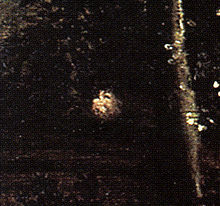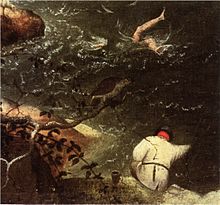Landscape with the fall of Icarus

|
| Landscape with the fall of Icarus |
|---|
| Pieter Bruegel the Elder (questionable) , around 1555–68 |
| Oil on canvas |
| 73.5 × 112 cm |
| Royal Museums of Fine Arts , Brussels |
The oil painting Landscape with the Fall of Icarus shows a scene from the Metamorphoses of Ovid in the style of the Dutch Renaissance . The best-known version is in the Royal Museums of Fine Arts in Brussels and measures around 73.5 centimeters in height and 112 centimeters in width. For a long time it was assumed that it came from the Flemish painter Pieter Bruegel the Elder . While his authorship of the composition is considered to be certain, it is doubtful whether he painted the specific version. It may be an early copy of an original by Bruegel.
A slightly different version of the painting is in the Brussels Museum Van Buuren . In this case, too, the possibility that it was made by Bruegel was discussed. However, it is now dated to a period after the painter's death.
Version in the Royal Museums of Fine Arts
Content and design
The main character is a farmer turning the clod , a shepherd is standing behind him, and a fisherman is sitting at the lower right of the picture. The view opens onto a bay that extends to the horizon with the sun disk on the horizon. Ships are cruising by the sea, and a white rocky mountain rises in the upper right corner. Diagonally above the plowing farmer lies a fortified rock island (apparently an allusion to the labyrinth from the myth ) and behind it a port city. In the lower left foreground you can see a wallet with a sword in it, next to it is a full sack of grain. Behind the horse, in the bushes, a face can be seen in penumbra, a dead man who is ignored by the plowing farmer, as is the Icarus falling in the background. The crashed Icarus is only small, to a certain extent only recognizable as a picture detail on the edge in the lower right half of the picture above the angler.
The shepherd is roughly in the center of the picture. Its upturned face lies at the intersection of the main and secondary diagonals. The viewer's point of view is on a hill. The farmer is shown diagonally above, the shepherd a little more from the side and the sailing ship above it from the front. By shifting the angle, the painter reinforces the impression of a great distance. The colors yellow, green and brown dominate, but the farmer's red shirt is striking.
Mythological basis
Icarus (. Greek Ikaros , lat. Icarus ) is from the Greek mythology known: his father Daedalus (Greek. Daedalus , lat. Daedalus ) was constructed wings with which he and his son fled from captivity in Crete. But when Icarus got too close to the sun in high spirits, the wax that held the feathers together melted and he fell to his death. The poet Ovid describes this in his Metamorphoses (VIII, 183-235) and the Ars amatoria (II, 21-96).
Before his exile to Crete , Daedalus threw his twelve-year-old pupil Perdix from the Acropolis out of displeasure , because he had invented saws and compasses despite his youth. Athene caught the boy, however, and turned him into a partridge , which flies close to the ground and builds its nests in hedges, because it "fears the heights, remembering the former fall". In the painting, the bird is sitting on a branch to the left of the angler. In the myth he flies to the funeral of Icarus.
Interpretations
It is significant that the painter only depicts the crashed Icarus in a marginal way: at the bottom right you can see him falling into the water, with his bare, kicking legs he makes a rather ridiculous figure. Some flying feathers can still be seen above him. Daedalus, one of the main characters, is even missing in the picture. On the other hand, the painting gives meaning to secondary characters such as farmers, shepherds and fishermen, whom Ovid also mentions:
"Some who fished with a swaying fishing rod, some shepherds, who leaned on their staff, some farmers who leaned on the plow, saw the two of them, marveled and thought they were gods because they could cross the high air."
However, the fisherman sits down by the water, the shepherd is placed in the middle, the farmer works his field and what they all have in common is that they are not interested in the fall of the Icarus. The sword in the purse and the sack of grain in the foreground mean the Flemish proverbs: "Money and sword need good hands" and "What is sown on rocks does not grow". They are allusions to the uselessness of Icarus' actions. The aphorism about the half-hidden corpse in the undergrowth is: "No plow stops because of a dying person". Farmer, shepherd and fisherman stoically obey the laws of nature and the cosmos . Even the partridge Perdix , who is happy about Icarus' death in the myth, ignores the victim and the ship (not mentioned in Ovid) leaves the scene of the accident with flared sails.
Bruegel put the legend of Icarus in his own time, as the landscape and the Mediterranean carracks typical of the 16th century speak for . These ships were then built in Dutch shipyards and the painter records them with great accuracy.
Contrary to the legend in which Icarus came too close to the sun, in this picture he crashes at almost the opposite point, whereas the sun either rises or sets. The contemporary Abraham Ortelius remarked in his book of friends : “Our Bruegel paints many things that cannot be painted at all. [...] In his works there is often more about thoughts than about painting. "
According to Jacques van Lennep , the following interpretation is possible: The farmer in the foreground would be an allusion to alchemical art. Alchemists compared their craft to agriculture and believed metals to be organisms that can grow and multiply. The shepherd leaning on the staff represents the god Hermes , who in his youth with his brother Apollo looked after the flocks of Admetus . The ship is supposed to allude to a compost bin and the sea to mercury . This is because a long and dangerous procedure is necessary before mercury forms a chemical compound and this is compared with the dangers of a ship voyage. The rising sun can also mean the renewal of the world through alchemy, so Icarus would be a failed alchemist.
In the drawing of the warship with the fall of Icarus , which is widely used as a copper engraving , Bruegel apparently adheres more closely to the subject: the sun is high in the sky and the father flies beneath the falling son. Nevertheless, the artist is much more interested in the faithfully depicted ship.
origin
The damaged and often painted over work was purchased in 1912 from a London antique dealer for the royal collections in Belgium . Signature , date and historical documents are missing.
reception
Bruegel's trivialization of the Icarus fall was processed literarily in the Low German-High German educational novel Heine Steenhagen wöll ju dat wiesen! The story of an ambitious man (1925) by Friedrich Ernst Peters and in WH Auden's poem Musée des Beaux Arts from 1940. In the story Ikaros by the Polish writer Jaroslaw Iwaszkiewicz , the painting serves as an allegory for the arrest of a boy in the street, ignored by passers-by during the German occupation of Warsaw in World War II .
Version in the Van Buuren Museum

|
| Landscape with the fall of Icarus |
|---|
| around 1590–95 |
| oil on wood |
| 63 × 90 cm |
| Van Buuren Museum , Brussels |
A second version, showing Daedalus high in the sky in the left half of the picture, appeared in 1935. According to the Van Buuren Museum in Belgium, it comes from the circle of Pieter Bruegel the Elder and was created around 1590–1595, at least two decades after the death of Pieter Bruegel the Elder. At 63 centimeters high and 90 centimeters wide, it is smaller than the version in the Royal Museums. It was also painted in oil colors as image carrier served wood.
See also
literature
- Ovid: Metamorphoses. Newly translated into prose by Gerhard Fink , Frankfurt am Main: Fischer Taschenbuch Verlag 1992/98, licensed edition from Artemis Verlag Zurich and Munich 1989 ISBN 3-596-10497-1 .
- Jean-Louis Ferrier: The adventures of seeing , Munich: Piper Verlag 1998 ISBN 3-492-04019-5 .
- Rose-Marie Hagen, Rainer Hagen: Pieter Bruegel the Elder Ä. - Peasants, fools and demons . Benedikt Taschen Verlag, Cologne 1999, ISBN 3-8228-6590-7 .
- Rose-Marie and Rainer Hagen: Masterpieces in Detail. Volume 2, Taschen Verlag, Cologne 2003.
- Beat Wyss : Landscape with an Icarus Fall. A picture puzzle of humanistic pessimism. Fischer TB, Frankfurt 1990 ISBN 3-596-23962-1
Web links
- Description détaillée: La chute d'Icare - the painting in the online catalog of the Royal Museums (French)
- Astrid Nettling: Wrong world. Pieter Bruegel's "Fall of Icarus" . Deutschlandfunk, December 4, 2019.
Individual evidence
- ↑ a b c d The adventures of seeing , p. 90 ff.
- ↑ Anna Blume: In the Wake of Production. A Study of Bruegel's Landscape with the Fall of Icarus . In: Donald E. Morse (Ed.): The Delegated Intellect. Emersonian Essays on Literature, Science, and Art in Honor of Don Gifford. Peter Lang, New York 1995, pp. 236–261, here p. 238 and Fig. 1a on p. 251 (PDF)
- ↑ Pieter Bruegel the Elder Ä. - Peasants, fools and demons. P. 61.
- ↑ a b Metamorphoses. P. 190 f.
- ↑ Metamorphoses. III, 216-220
- ↑ The adventure of seeing. P. 93.
- ↑ Jacques van Lennep: Art et alchimie. Brussels 1966, pp. 340–365.
- ^ Rose-Marie Hagen, Rainer Hagen: Pieter Bruegel the Elder. Ä. - Peasants, fools and demons . Benedikt Taschen Verlag, Cologne 1999, ISBN 3-8228-6590-7 , p. 60 .
- ↑ In Polish ; as a German extract often in various school books; Complete translation Klaus-Dieter Staemmler: Ikaros , in The great masters. European storytellers of the 20th century, Vol. 2. Ed. Rolf Hochhuth . Bertelsmann Lesering (1966), pp. 410-414; previously told in: Gerda Hagenau ed., Poland. 22 stories . Fischer TB, 1961
- ↑ Anna Fattori - Lecture at the annual conference of the Robert Walser Society in Stuttgart June 23, 2007 (PDF; 651 kB) accessed on September 24, 2011
- ^ Museum Van Buuren. Archived from the original on October 19, 2009 ; accessed on December 7, 2013 .



